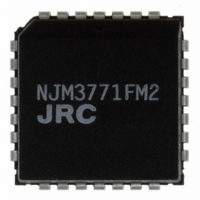NJM3771FM2# NJR, NJM3771FM2# Datasheet - Page 3

NJM3771FM2#
Manufacturer Part Number
NJM3771FM2#
Description
IC STEPPER MOTOR DUAL DVR 28PLCC
Manufacturer
NJR
Datasheet
1.NJM3771FM2.pdf
(9 pages)
Specifications of NJM3771FM2#
Applications
Stepper Motor Driver, 2 Phase
Number Of Outputs
1
Current - Output
650mA
Voltage - Load
10 V ~ 40 V
Voltage - Supply
4.75 V ~ 5.25 V
Operating Temperature
-20°C ~ 125°C
Mounting Type
Surface Mount
Package / Case
28-PLCC
Lead Free Status / RoHS Status
Lead free / RoHS Compliant
Other names
NJM#3771FM2
NJM#3771FM2
NJM#3771FM2
Available stocks
Company
Part Number
Manufacturer
Quantity
Price
Each channel of the NJM3771 consists of the following sections: an H-bridge output stage, capable of driving up
to 650 mA continuous motor current (or 500 mA, both channels driven), a logic section that controls the output
transistors, an S-R flip-flop, and two comparators. The oscillator is common to both channels.
voltage across a current-sensing resistor, R
that voltage back to a comparator. When the motor current reaches a threshold level, determined by the voltage at
the reference input, V
decreases until the clock oscillator triggers the flip-flop, which turns on the output transistors again, and the cycle is
repeated.
input.
supply) is switched on and off, while one of the upper transistors is held constantly on. During turn-off, the current
recirculates through the upper transistor (which one depends on current direction) and the corresponding free-
wheeling diode connected to V
ing current is opposed by the supply voltage, causing a rapid discharge of energy in the winding.
are necessary. Slow current decay, however, gives less current ripple, and should always be selected, if possible,
to minimize core losses and switching noise.
Constant current control is achieved by switching the current to the windings. This is done by sensing the (peak)
The current-decay rate during the turn-off portion of the switching cycle, can be selected fast or slow by the CD
In slow current-decay mode, only one of the lower transistors in the H-bridge (those closest to the negative
In fast current decay mode, both the upper and lower transistors are switched. During the off-time, the freewheel-
Fast current decay may be required in half- and microstepping applications when rapid changes of motor current
FUNCTIONAL DESCRIPTION
R
, the comparator resets the flip-flop, which turns off the output transistors. The current
MM
, see figure 3.
Figure 3. Output stage with current paths
during turn -on, turn-off and phase shift
Motor Current
S
, effectively connected in series with the motor winding, and feeding
2 1
3
FAST Current Decay
SLOW Current Decay
1
R
s
2
3
Time
NJM3771




















